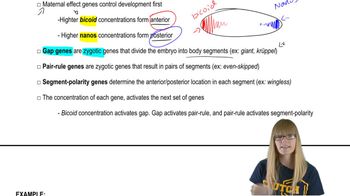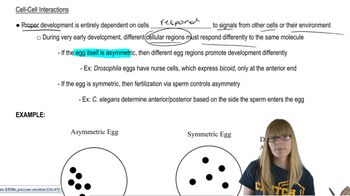The bicoid gene is a coordinate maternal–effect gene. A female that is homozygous for a loss-of-function bicoid allele is mated to a wild-type male. What are the phenotypes of their progeny?
Table of contents
- 1. Introduction to Genetics51m
- 2. Mendel's Laws of Inheritance3h 37m
- 3. Extensions to Mendelian Inheritance2h 41m
- 4. Genetic Mapping and Linkage2h 28m
- 5. Genetics of Bacteria and Viruses1h 21m
- 6. Chromosomal Variation1h 48m
- 7. DNA and Chromosome Structure56m
- 8. DNA Replication1h 10m
- 9. Mitosis and Meiosis1h 34m
- 10. Transcription1h 0m
- 11. Translation58m
- 12. Gene Regulation in Prokaryotes1h 19m
- 13. Gene Regulation in Eukaryotes44m
- 14. Genetic Control of Development44m
- 15. Genomes and Genomics1h 50m
- 16. Transposable Elements47m
- 17. Mutation, Repair, and Recombination1h 6m
- 18. Molecular Genetic Tools19m
- 19. Cancer Genetics29m
- 20. Quantitative Genetics1h 26m
- 21. Population Genetics50m
- 22. Evolutionary Genetics29m
14. Genetic Control of Development
Developmental Patterning Genes
Problem 14
Textbook Question
Embryogenesis and oncogenesis (generation of cancer) share a number of features including cell proliferation, apoptosis, cell migration and invasion, formation of new blood vessels, and differential gene activity. Embryonic cells are relatively undifferentiated, and cancer cells appear to be undifferentiated or dedifferentiated. Homeotic gene expression directs early development, and mutant expression leads to loss of the differentiated state or an alternative cell identity. M. T. Lewis [(2000). Breast Can. Res. 2:158–169] suggested that breast cancer may be caused by the altered expression of homeotic genes. When he examined 11 such genes in cancers, 8 were underexpressed while 3 were overexpressed compared with controls. Given what you know about homeotic genes, could they be involved in oncogenesis?
 Verified step by step guidance
Verified step by step guidance1
Understand the role of homeotic genes: Homeotic genes are responsible for regulating the development of body structures during embryogenesis. They control the identity and differentiation of cells, ensuring that tissues and organs form in the correct locations. Mutations or altered expression of these genes can lead to developmental abnormalities or changes in cell identity.
Compare embryogenesis and oncogenesis: Both processes involve key features such as cell proliferation, apoptosis (programmed cell death), cell migration, invasion, and differential gene activity. Cancer cells often exhibit characteristics similar to embryonic cells, such as being undifferentiated or dedifferentiated, which suggests a potential link between the two processes.
Analyze the altered expression of homeotic genes in cancer: The study mentioned in the problem found that 8 homeotic genes were underexpressed and 3 were overexpressed in breast cancer compared to controls. This suggests that the normal regulatory functions of these genes may be disrupted, potentially leading to loss of differentiation or changes in cell identity, which are hallmarks of cancer.
Consider the implications of underexpression and overexpression: Underexpression of homeotic genes may result in cells losing their specialized functions, reverting to a less differentiated state. Overexpression could lead to inappropriate activation of developmental pathways, causing abnormal growth or invasion, which are characteristic of cancer cells.
Conclude the potential involvement of homeotic genes in oncogenesis: Based on their role in regulating cell identity and differentiation, and the observed changes in their expression in cancer, it is plausible that homeotic genes could contribute to oncogenesis. Further research would be needed to establish the specific mechanisms and pathways involved.
 Verified video answer for a similar problem:
Verified video answer for a similar problem:This video solution was recommended by our tutors as helpful for the problem above
Video duration:
1mPlay a video:
Was this helpful?
Key Concepts
Here are the essential concepts you must grasp in order to answer the question correctly.
Homeotic Genes
Homeotic genes are crucial regulatory genes that control the body plan and the identity of body segments during embryonic development. They determine the formation of specific structures in the correct locations, and mutations in these genes can lead to developmental abnormalities. In the context of cancer, altered expression of homeotic genes can disrupt normal differentiation processes, potentially leading to the formation of tumors.
Recommended video:
Guided course

Segmentation Genes
Cell Differentiation
Cell differentiation is the process by which unspecialized cells, such as embryonic stem cells, develop into specialized cells with distinct functions. This process is tightly regulated by gene expression and signaling pathways. In cancer, cells may lose their differentiated state, becoming more stem-like or undifferentiated, which contributes to uncontrolled growth and the ability to invade other tissues.
Recommended video:
Guided course

Cell-cell interactions
Oncogenesis
Oncogenesis refers to the process by which normal cells transform into cancer cells, involving genetic mutations and changes in cellular behavior. Key features of oncogenesis include increased cell proliferation, evasion of apoptosis, and enhanced migration and invasion capabilities. Understanding the genetic and molecular mechanisms behind oncogenesis, including the role of homeotic genes, is essential for developing targeted cancer therapies.
Related Videos
Related Practice
Textbook Question
934
views


